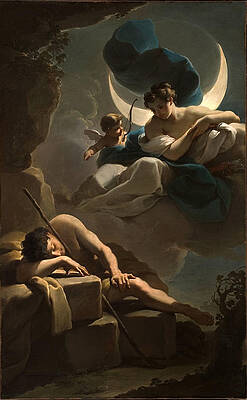.
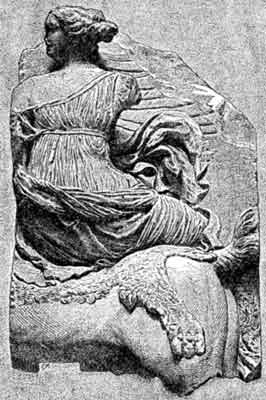
Selene, Pergamon Zeus Altar
In Greek mythology, Selene (Σελήνη, "moon") (Roman equivalent: Luna) was an ancient lunar deity, traditionally one of the race of titans, and the daughter of Theia and Hyperion. She was eventually largely supplanted by Artemis, thus, later writers sometimes describe her as a daughter of Zeus, or of Pallas - in the Homeric Hymn to Hermes., she is "bright Selene, daughter of the lord Pallas, Megamedes' son."
In the traditional divine geneology, Helios, the sun, is her brother, and her sister Eos is goddess of the dawn.
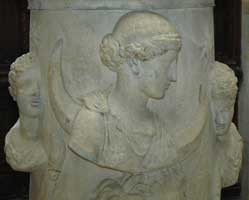
She loved a handsome shepherd (or, more rarely, a king or a hunter) named Endymion from Asia Minor. He was so beautiful that Selene asked Zeus to grant him eternal life so he would never leave her. Alternatively, Endymion made the decision to live forever in sleep. Either way, Zeus blessed him by putting him into an eternal sleep. Every night, Selene visited him where he was buried on Mt. Latmus near Milete, in Asia Minor. Selene and Endymion had fifty daughters including Naxos.
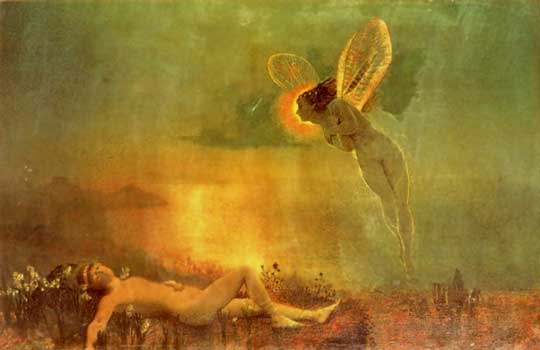
Selene visits Endymion on Mount Latmus, John Atkinson Grimshaw 1879
Though the story of Endymion is best known today, Selene also had three daughters with Zeus (including Pandia) and, according to some sources, the Nemean Lion as well. She also had an affair with Pan, who gave her a herd of white oxen.
In art, Selene was depicted as a beautiful woman with a pale face, riding a silver chariot pulled by two horses. Often, she was shown riding a horse or bull, wearing robes and a half-moon on her head and carrying a torch.
After her brother, Helios, the sun, finished his journey across the sky, Selene began hers as night fell upon the earth.
In Rome, Luna ("moon") had a temple on the Aventine Hill. It was built in the 6th century BC but destroyed in the fire under Nero.
In the collection known as the Homeric hymns there is a Hymn to Selene Selene is described in Apollodorus 1.2.2; Hesiod's Theogony 371; Nonnius 48.581; Pausanias 5.1.4; and Strabo 14.1.6, among others.
The name is the root of selenology, the study of the moon that corresponds to geology. The name appears in fiction as the character Adam Selene in the novel The Moon is a Harsh Mistress by Robert A. Heinlein.
The Finnish power metal band Sonata Arctica makes a reference to her in their song "My Selene", from their album Reckoning Night. Some of the lyrics that suggest this would be: "Solitude's upon my skin. A life that's bound by the chains of reality. Would you let me be your Endymion?"
Also, the Guatemalan band "La Tona" named its [arguably] greatest hit "Selene". Various analogies and references to the lunar behavior are presented there.

The Chariot Horse of Selene, East Parthenon Pediment, 447-432 BC.
Selene and Endymion, Ubaldo Gandolfi
Selene and Endymion, Nicolas Poussin
Selene and Endymion, Attributed to Johann Carl Loth
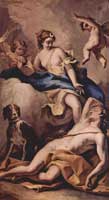
The chemical element selenium was named after Selene.
Selene (Anna Hempstead Branch)
Reference
Gods of the Greeks, Carl Kerenyi
The Homeric Hymns, 2nd Edition
See also : Greek Mythology. Paintings, Drawings
| Ancient Greece
Science, Technology , Medicine , Warfare, , Biographies , Life , Cities/Places/Maps , Arts , Literature , Philosophy ,Olympics, Mythology , History , Images Medieval Greece / Byzantine Empire Science, Technology, Arts, , Warfare , Literature, Biographies, Icons, History Modern Greece Cities, Islands, Regions, Fauna/Flora ,Biographies , History , Warfare, Science/Technology, Literature, Music , Arts , Film/Actors , Sport , Fashion --- |
Retrieved from "http://en.wikipedia.org"
All text is available under the terms of the GNU Free Documentation License

